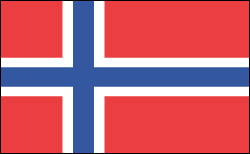NORWAY

Geography: Norway is situated in the western part of the Scandinavian peninsula. It extends about 1,100 mi (1,770 km) from the North Sea along the Norwegian Sea to more than 300 mi (483 km) above the Arctic Circle, the farthest north of any European country. It is slightly larger than New Mexico. Nearly 70% of Norway is uninhabitable and covered by mountains, glaciers, moors, and rivers. The hundreds of deep fjords that cut into the coastline give Norway an overall oceanfront of more than 12,000 mi (19,312 km). Galdhø Peak, at 8,100 ft (2,469 m), is Norway's highest point and the Glåma (Glomma) is the principal river, at 372 mi (598 km) long.
Government: Constitutional monarchy.
History: Norwegians, like the Danes and Swedes, are of Teutonic origin. The Norsemen, also known as Vikings, ravaged the coasts of northwest Europe from the 8th to the 11th century and were ruled by local chieftains. Olaf II Haraldsson became the first effective king of all Norway in 1015 and began converting the Norwegians to Christianity. After 1442, Norway was ruled by Danish kings until 1814, when it was united with Sweden—although retaining a degree of independence and receiving a new constitution—in an uneasy partnership. In 1905, the Norwegian parliament arranged a peaceful separation and invited a Danish prince to the Norwegian throne—King Haakon VII. A treaty with Sweden provided that all disputes be settled by arbitration and that no fortifications be erected on the common frontier.
Government: Constitutional monarchy.
History: Norwegians, like the Danes and Swedes, are of Teutonic origin. The Norsemen, also known as Vikings, ravaged the coasts of northwest Europe from the 8th to the 11th century and were ruled by local chieftains. Olaf II Haraldsson became the first effective king of all Norway in 1015 and began converting the Norwegians to Christianity. After 1442, Norway was ruled by Danish kings until 1814, when it was united with Sweden—although retaining a degree of independence and receiving a new constitution—in an uneasy partnership. In 1905, the Norwegian parliament arranged a peaceful separation and invited a Danish prince to the Norwegian throne—King Haakon VII. A treaty with Sweden provided that all disputes be settled by arbitration and that no fortifications be erected on the common frontier.

Map of Norway
Sovereign: King Harald V (1991)
Prime Minister: Erna Solberg
(2013)
Land area: 118,865 sq mi (307,860 sq km);
total area: 125,181 sq mi (324,220 sq km)
Population (2014 census): 5,147,792 (growth
rate: 1.19%); birth rate: 12.09/1000; infant mortality rate: 2.48/1000;
life expectancy: 81.6
Capital and largest city (2011 est.):
Oslo, 915,000
Other large cities: Bergen, 270,600;
Stavanger, 197,852; Trondheim, 170,242
Monetary unit: Norwegian krone
National
name: Kongeriket Norge
Languages:
Bokmål Norwegian (official), Nynorsk Norwegian (official), small Sami- and Finnish-speaking minorities
note: Sami is an official language in nine municipalities
Ethnicity/race:
Norwegian 94.4% (includes Sami, about 60,000), other European 3.6%, other 2% (2007 estimate)
Religions:
Church of Norway (Evangelical Lutheran - official) 82.1%,
other Christian 3.9%, Muslim 2.3%, Roman Catholic 1.8%, other 2.4%,
unspecified 7.5% (2011 est.)
National Holiday:
Constitution Day, May 17
Literacy rate: 100%
Economic summary: GDP/PPP (2013 est.):
$282.2 billion; per capita $55,400. Real growth rate: 1.6%.
Inflation: 1.9%. Unemployment: 3.6%. Arable land:
2.52%. Agriculture: barley, wheat, potatoes; pork, beef, veal,
milk; fish. Labor force: 2.707 million; services 77.6%, industry
20.2%, agriculture, forestry, and fishing 2.2% (2012). Industries:
petroleum and gas, food processing, shipbuilding, pulp and paper
products, metals, chemicals, timber, mining, textiles, fishing.
Natural resources: petroleum, copper, natural gas, pyrites,
nickel, iron ore, zinc, lead, fish, timber, hydropower.
Exports: $154.2 billion (2013 est.): petroleum and
petroleum products, machinery and equipment, metals, chemicals, ships,
fish. Imports: $90.14 billion (2013 est.): machinery and
equipment, chemicals, metals, foodstuffs. Major trading
partners: UK, Germany, Netherlands, France, U.S., Sweden, Denmark,
China (2012).
Communications:
Telephones: main lines in use: 1.465 million (2012); mobile
cellular: 5.732 million (2012). Broadcast media: state-owned
public radio-TV broadcaster operates 3 nationwide TV stations, 3
nationwide radio stations, and 16 regional radio stations; roughly a
dozen privately owned television stations broadcast nationally and
roughly another 25 local TV stations broadcasting; nearly 75% of
households have access to multi-channel cable or satellite TV; 2
privately owned radio stations broadcast nationwide and another 240
stations operate locally (2008).
Internet hosts: 3.588 million (2012).
Internet users: 4.431 million (2009).
Transportation: Railways: total: 4,237 km
(2012). Roadways: total: 93,870 km; paved: 75,754 km (includes
393 km of expressways); unpaved: 18,116 km (2013). Waterways:
1,577 km (2010). Ports and harbors: Bergen, Haugesund, Maaloy, Mongstad, Narvik, Sture. Airports: 95
(2013).
International disputes:
Norway asserts a territorial claim in Antarctica (Queen Maud Land and
its continental shelf); Denmark (Greenland) and Norway have made
submissions to the Commission on the Limits of the Continental shelf
(CLCS) and Russia is collecting additional data to augment its 2001 CLCS
submission; Norway and Russia signed a comprehensive maritime boundary
agreement in 2010.
-------------------- o --------------------
No comments:
Post a Comment